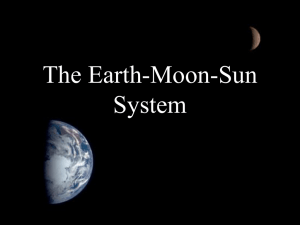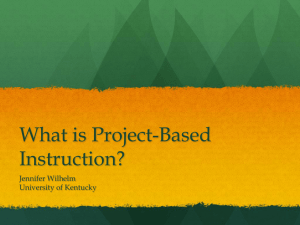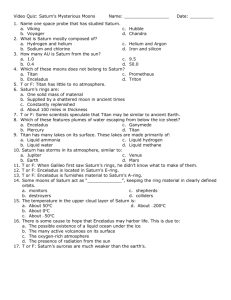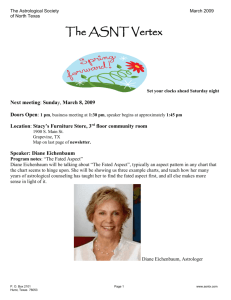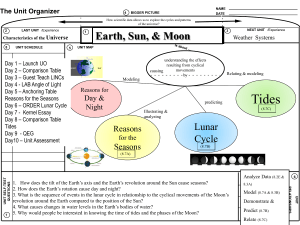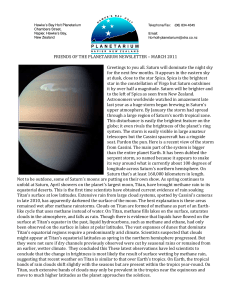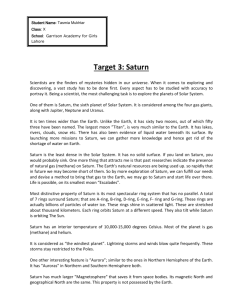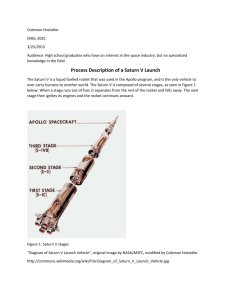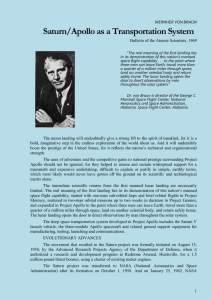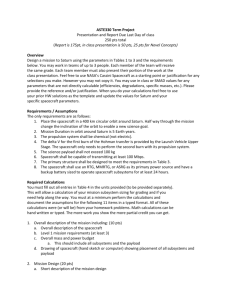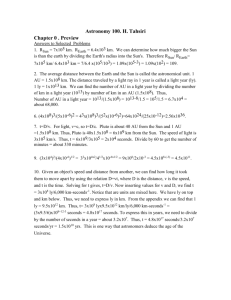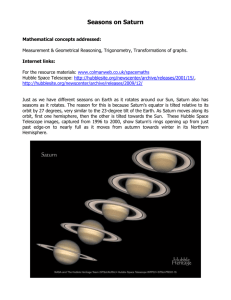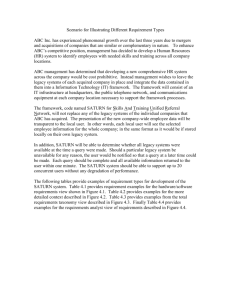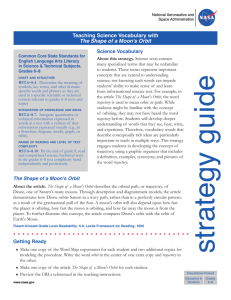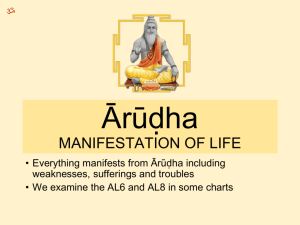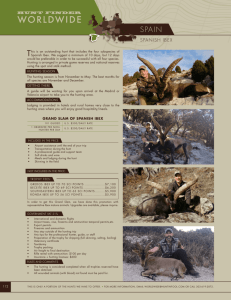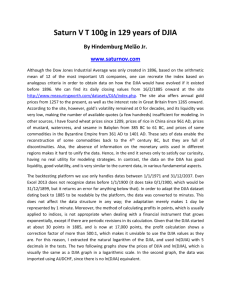Star Stories - Museum of Discovery and Science
advertisement
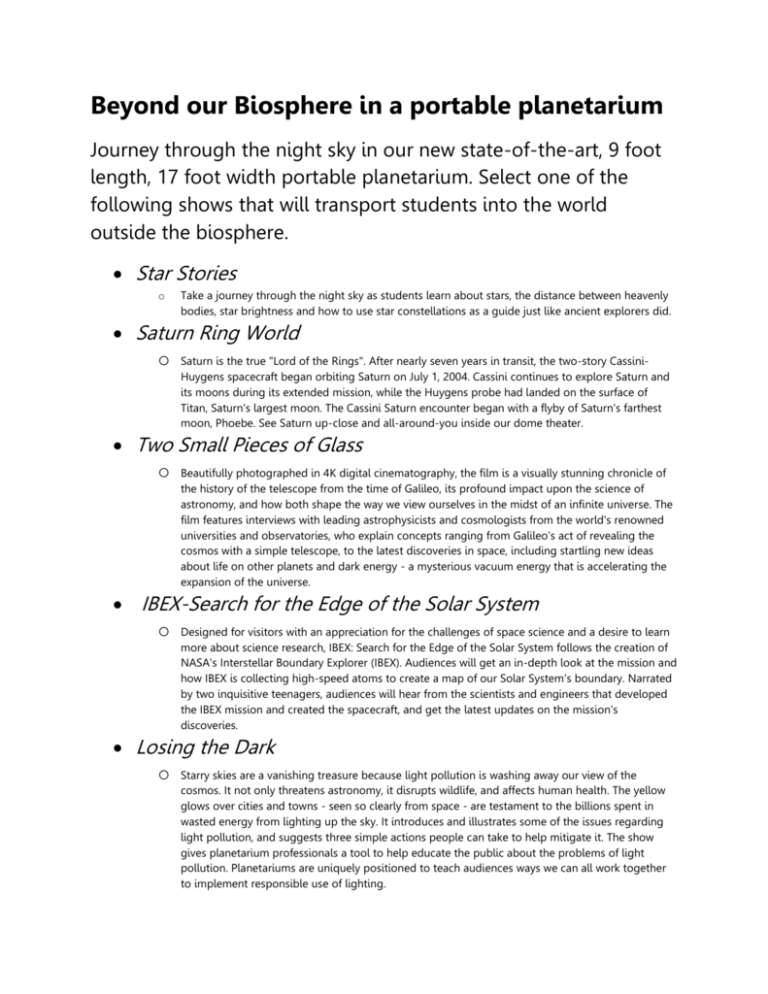
Beyond our Biosphere in a portable planetarium Journey through the night sky in our new state-of-the-art, 9 foot length, 17 foot width portable planetarium. Select one of the following shows that will transport students into the world outside the biosphere. Star Stories o Take a journey through the night sky as students learn about stars, the distance between heavenly bodies, star brightness and how to use star constellations as a guide just like ancient explorers did. Saturn Ring World o Saturn is the true "Lord of the Rings". After nearly seven years in transit, the two-story CassiniHuygens spacecraft began orbiting Saturn on July 1, 2004. Cassini continues to explore Saturn and its moons during its extended mission, while the Huygens probe had landed on the surface of Titan, Saturn's largest moon. The Cassini Saturn encounter began with a flyby of Saturn's farthest moon, Phoebe. See Saturn up-close and all-around-you inside our dome theater. Two Small Pieces of Glass o Beautifully photographed in 4K digital cinematography, the film is a visually stunning chronicle of the history of the telescope from the time of Galileo, its profound impact upon the science of astronomy, and how both shape the way we view ourselves in the midst of an infinite universe. The film features interviews with leading astrophysicists and cosmologists from the world's renowned universities and observatories, who explain concepts ranging from Galileo's act of revealing the cosmos with a simple telescope, to the latest discoveries in space, including startling new ideas about life on other planets and dark energy - a mysterious vacuum energy that is accelerating the expansion of the universe. IBEX-Search for the Edge of the Solar System o Designed for visitors with an appreciation for the challenges of space science and a desire to learn more about science research, IBEX: Search for the Edge of the Solar System follows the creation of NASA's Interstellar Boundary Explorer (IBEX). Audiences will get an in-depth look at the mission and how IBEX is collecting high-speed atoms to create a map of our Solar System's boundary. Narrated by two inquisitive teenagers, audiences will hear from the scientists and engineers that developed the IBEX mission and created the spacecraft, and get the latest updates on the mission's discoveries. Losing the Dark o Starry skies are a vanishing treasure because light pollution is washing away our view of the cosmos. It not only threatens astronomy, it disrupts wildlife, and affects human health. The yellow glows over cities and towns - seen so clearly from space - are testament to the billions spent in wasted energy from lighting up the sky. It introduces and illustrates some of the issues regarding light pollution, and suggests three simple actions people can take to help mitigate it. The show gives planetarium professionals a tool to help educate the public about the problems of light pollution. Planetariums are uniquely positioned to teach audiences ways we can all work together to implement responsible use of lighting. Flight Adventures o Discover the science of flight through the eyes of a young girl and her grandfather as they explore how birds, kites, planes and models fly. Learn about the history and future plans of flight and how NASA is discovering new and safer ways to travel with the help of future engineers and aviators like YOU! Back to the Moon for Good o This film, narrated by Tim Allen highlights the history of exploring the moon and provides an insider's look at the teams vying for the $30 million Google Lunar XPRIZE, the largest incentivized prize in history. It begins with a tour through the history of lunar exploration, tracing back to the 1960s and 1970s. We hear from some of the teams racing to land a robotic spacecraft on the moon and win the Google Lunar XPRIZE. The audience is taken on a successful launch, landing and tour of the lunar surface. The show ends with an enticing visualization of a future settlement on the moon. The stunning visuals and compelling narrative of the show explain the importance of the Google Lunar XPRIZE in encouraging today's space entrepreneurs and innovators to collaborate toward building a new space economy while inspiring the next generation to "shoot for the moon." The Search for Life in the Universe o 2010 marked the 50th anniversary of the first experiment to search for extraterrestrial intelligence. In 1960, astronomer Frank Drake used a radio telescope in Green Bank, West Virginia to listen to two nearby stars. He heard nothing interesting, but the idea of searching for life beyond Earth was born. Fifty years of searching for signals and occasional broadcasting of messages has not detected any transmissions that require intelligent alien authors. Either intelligent life is much more rare or short-lived than we expected or we are not looking in the right places with the right tools. The Search For Life In The Universe takes a fresh look at this fifty-year-old question, looking forward from the big bang, in search of those special places that might harbor life, including all of the planets in our solar system. It's a beautiful scenic tour of our universe through the eyes of astronomers looking for clues about the origin of life and the development of intelligence. The vistas are breathtaking from stellar birth clouds like the Orion and Trifid Nebulas to the death throes of Eta Carinae and the mysterious surfaces of nearby planets, their moons and rings. Join the search and enjoy the adventure. PLEASE NOTE: Our portable planetarium can only be booked for indoor facilities. Ceilings 12 feet or taller are required. Please make sure you have proper space before booking. Grades 2-5: 30 students max. Grades 6-8: 25 students max. Teachers from Title 1 schools should contact 954.713.0930 for information regarding FREE Beyond our Biosphere in a portable planetarium Outreaches given to the Museum by the Community Foundation and the Beyond the Karman Line: A Comprehensive Learning Initiative in Space Science grant.

